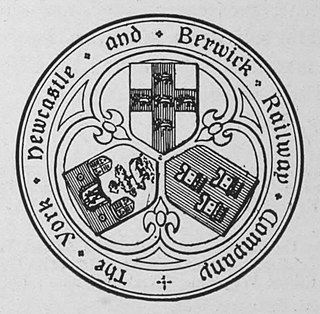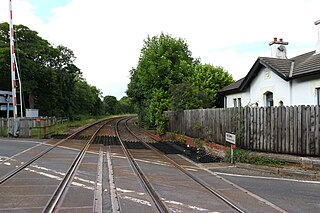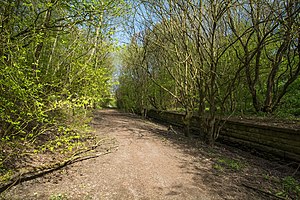
The Tanfield Railway is a 4 ft 8+1⁄2 instandard gauge heritage railway in Gateshead and County Durham, England. Running on part of a former horse-drawn colliery wooden waggonway, later rope & horse, lastly rope & loco railway. It operates preserved industrial steam locomotives. The railway operates a passenger service every Sunday, plus other days, as well as occasional demonstration coal, goods and mixed trains. The line runs 3 miles (4.8 km) between a southern terminus at East Tanfield, Durham, to a northern terminus at Sunniside, Gateshead. Another station, Andrews House, is situated near the Marley Hill engine shed. A halt also serves the historic site of the Causey Arch. The railway claims it is "the world's oldest railway" because it runs on a section dating from 1725, other parts being in use since 1621.

The North Eastern Railway (NER) was an English railway company. It was incorporated in 1854 by the combination of several existing railway companies. Later, it was amalgamated with other railways to form the London and North Eastern Railway at the Grouping in 1923. Its main line survives to the present day as part of the East Coast Main Line between London and Edinburgh.

The Durham Coast Line is an approximately 39.5-mile (63.6 km) railway line running between Newcastle and Middlesbrough in North East England. Heavy rail passenger services, predominantly operated Northern Trains, and some freight services operate over the whole length of the line; it provides an important diversionary route at times when the East Coast Main Line is closed. Light rail services of the Tyne and Wear Metro's Green Line also operate over the same tracks between a junction just south of Sunderland station and Pelaw Junction.

The Leamside Line, originally part of the Durham Junction Railway, is a disused railway line, located in the North East of England. The alignment diverges from the East Coast Main Line at Tursdale Junction, travelling a distance of 21 miles north through the Durham Coalfield and Washington, prior to joining the Durham Coast Line at Pelaw Junction. The Leamside Line closed to passenger traffic in 1964, under the Beeching cuts.

Stockton is a railway station on the Durham Coast Line, which runs between Newcastle and Middlesbrough via Hartlepool. The station, situated 5 miles 45 chains (9.0 km) west of Middlesbrough, serves the market town of Stockton-on-Tees in County Durham, England. It is owned by Network Rail and managed by Northern Trains.

Seaham is a railway station on the Durham Coast Line, which runs between Newcastle and Middlesbrough via Hartlepool. The station, situated 5 miles 11 chains (8.3 km) south-east of Sunderland, serves the seaside town of Seaham in County Durham, England. It is owned by Network Rail and managed by Northern Trains.

The York, Newcastle and Berwick Railway (YN&BR) was an English railway company formed in 1847 by the amalgamation of the York and Newcastle Railway and the Newcastle and Berwick Railway. Both companies were part of the group of business interests controlled by George Hudson, the so-called Railway King. In collaboration with the York and North Midland Railway and other lines he controlled, he planned that the YN&BR would form the major part of a continuous railway between London and Edinburgh. At this stage the London terminal was Euston Square and the route was through Normanton. This was the genesis of the East Coast Main Line, but much remained to be done before the present-day route was formed, and the London terminus was altered to King's Cross.
Lambton Collieries was a privately owned colliery and coal mining company, based in County Durham, England.

The Clarence Railway was an early railway company that operated in north-east England between 1833 and 1853. The railway was built to take coal from mines in County Durham to ports on the River Tees and was a competitor to the Stockton and Darlington Railway (S&DR). It suffered financial difficulty soon after it opened because traffic was low and the S&DR charged a high rate for transporting coal to the Clarence, and the company was managed by the Exchequer Loan Commissioners after July 1834. An extension of the Byers Green branch was opened in 1839 by the independent West Durham Railway to serve collieries in Weardale.

Ferryhill railway station was located in Ferryhill, County Durham, Northeast England. It was located on what became the East Coast Main Line between Darlington and Durham, close to the junctions with several former branches, including the extant freight-only Stillington Line to Norton-on-Tees and Stockton.

Ryhope East was one of two railway stations to have served the village of Ryhope, Tyne and Wear, North East England. Opened in 1858 as a stop on the short Londonderry, Seaham and Sunderland Railway, it became a minor stop on the Durham Coast Line following that line's incorporation into it in 1905.

Hartlepool railway station was a railway station that served the Headland area of Hartlepool in the ceremonial county of Durham, North East England. Though originally built as the coastal terminus of the Hartlepool Dock & Railway in 1839, for most of its life the station was the terminus of a shuttle service from the town's main station in West Hartlepool.

Seaham Hall Dene railway station was a private railway station that served Seaham Hall, the then a home of the Marquess of Londonderry close to the town of Seaham, County Durham, England from 1875 to 1925 on the Durham Coast Line.

Horden is a railway station on the Durham Coast Line, which runs between Newcastle and Middlesbrough via Hartlepool. The station, situated 10 miles 74 chains (17.6 km) south-east of Sunderland, serves the villages of Horden, Blackhall Colliery and Easington along with the town of Peterlee in County Durham, North East England. It is owned by Network Rail and managed by Northern Trains.

Blackhall Colliery railway station served the village of Blackhall Colliery in County Durham, North East England. It was located on the Durham Coast Line, north of Blackhall Rocks and south of Horden.

Wellfield railway station was a railway station that served the village of Wingate in County Durham, England. It was built by the North Eastern Railway (NER) on the route of the Hartlepool Dock & Railway (HD&R) to allow interchange between the existing line and their newly opened line from Stockton-on-Tees.

Seaham Harbour railway station was a railway station that served the town of Seaham Harbour in County Durham, North East England. For much of its existence, it was the southern passenger terminus of the Londonderry, Seaham and Sunderland Railway but declined in importance after the opening of the nearby Seaham Colliery station and the extension of the line to West Hartlepool by that company's successor.

Ryhoperailway station was one of two railway stations to have served the village of Ryhope, Tyne & Wear. For much of its existence, it was served by the Durham–Sunderland and Hartlepool–Haswell–Sunderland lines.

Hart railway station was a station that served the villages of Hart and Crimdon in County Durham, England.


















